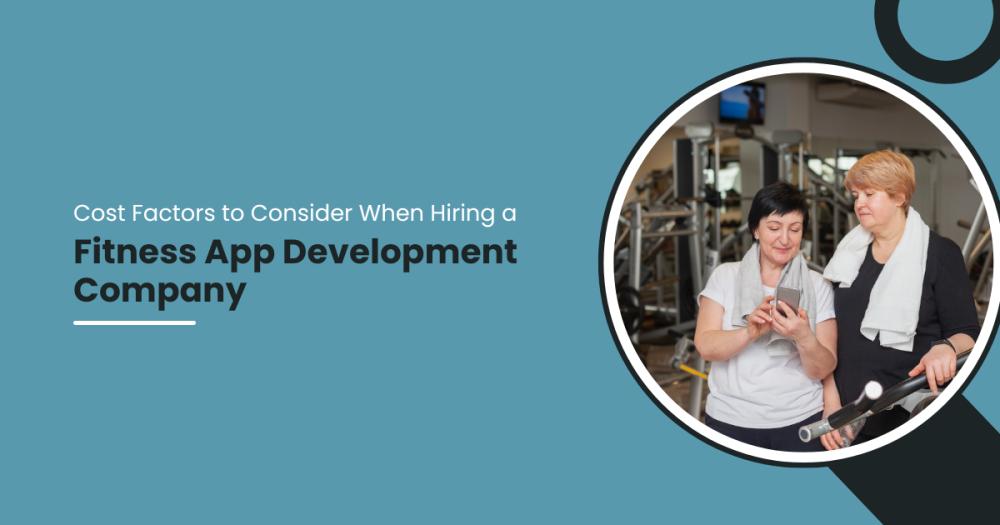
Cost Factors to Consider When Hiring a Fitness App Development Company

In 2024, global fitness app revenue surpassed $13.2 billion, growing at over 22% annually. This growth drives companies and startups to partner with a Fitness App Development Company for mobile development. Knowing cost factors saves time and money. This article outlines technical, business, and maintenance considerations when hiring development partners.
Why Costs Vary Between Development Firms
Every Fitness App Development Company defines costs differently. Project size, team skill sets, region, and feature complexity all influence pricing. Tech-stack choices and compliance requirements also add cost. Realistic budgeting starts with understanding how firms calculate cost.
Project Scope and App Complexity
Define your project scope clearly. A basic workout tracker costs less than an app with live video, AI coaching, or wearable integration. Features such as user profiles, social sharing, and personalization add complexity. A well-scoped project avoids extra rounds of development and hidden fees.
Platform Selection: iOS vs. Android vs. Both
Developers build native iOS and Android apps using Swift and Kotlin respectively. Each platform requires separate codebases and teams, doubling costs. A cross-platform approach with Flutter or React Native uses shared code but may reduce performance. Native apps often deliver better UX but cost more. Discuss platform strategy with your firm.
UI/UX Design and Visual Experience
High-quality UI/UX significantly increases development cost. Fitness apps need clean interfaces for workouts, stats, and navigation. Custom animations or rich graphical elements require design specialists and may involve several iterations. User testing adds cost but delivers better engagement.
Backend Infrastructure and Server Expenses
Most apps require a backend for user accounts, workout data, media files, and analytics. Using AWS, GCP, or Azure introduces costs for servers, databases, storage, and bandwidth. As user count rises, infrastructure must scale, increasing cloud charges. Fitness App Development Company quotes often include projected cloud cost.
Integration with Wearables and Devices
Apps often sync user data from devices like Apple Watch, Fitbit, or Oura. Each integration requires API access, synchronization logic, and extended testing. Managing data accuracy and time zones adds complexity. Every device integration incurs additional development effort and testing time.
Real-Time Features and Notifications
If your app uses live classes, chat, or streaming, you’ll need real-time messaging or video infrastructure. These features require WebSocket, signal servers, and media servers. Push notifications also need backend support. Real-time features increase both development and maintenance costs.
Analytics, Personalization, and Reporting
Integrating analytics tools Firebase Analytics, Amplitude, Mixpanel tracks user engagement and behavior. Custom dashboards with charts, filters, and KPIs require extra frontend and backend work. Gathering and displaying user or coach-specific reports adds to backend complexity and cost.
Security and Data Protection
Fitness apps often collect sensitive health data. They must comply with regulations like GDPR (EU) or HIPAA (US). Security measures include encrypted data at rest, token-based authentication, secure APIs, and audit logs. A Fitness App Development Company must also budget for penetration testing and security audits.
Also Read: Fitness App Development Cost: MyFitnessPal, Nike Training Clone
Quality Assurance and Testing
QA takes significant time and cost. Projects need unit testing, integration testing, and manual testing across devices. Fitness apps face varied screen sizes and OS versions. Automated testing frameworks reduce manual testing but add initial setup costs.
Ongoing Maintenance and Updates
After launching an app, continuous updates and bug fixes drive additional cost. Maintenance includes updating libraries, supporting new OS versions, improving features, and fixing bugs. Companies often budget 15–20% of initial development cost annually for these activities.
Team Structure and Location
Developer rates vary by region and skillset. US-based developers charge $150–250/hour. Eastern Europe charges $50–100/hour. South Asia averages $25–50/hour. Offshore development can reduce cost, but you may face time zones and communication gaps. Senior talent demands higher hourly rates.
Project Management and Communication
Custom development requires oversight. Project managers coordinate sprints, reviews, and client communication. Tools like Jira, Trello, or Asana help track progress. Effective coordination prevents scope creep but adds hourly costs.
Licensing Fees and Third‑Party Tools
Many apps rely on third-party services. These include video streaming (e.g., Vimeo, AWS IVS), analytics tools, payment systems, messaging platforms, and mapping services. These services require licensing fees or subscription plans. A Fitness App Development Company will separate service costs from development fees.
App Store Submission and Compliance
Deploying apps to Apple App Store and Google Play Store requires app metadata, screenshots, icons, privacy policies, and sometimes promotional media. Firms often charge separately for store support, metadata optimization, and compliance checks.
Actual expenses vary widely based on region and app scope. Always request a detailed breakdown when engaging a firm.
Case Study — FitCoach Pro
FitCoach Pro partnered with an Eastern European Fitness App Development Company. They chose React Native and AWS. Core features included live video, workout tracking, and AI-driven routines. Development took seven months and cost $210,000. They saved 35% compared to US rates. Their first-year maintenance ran at $35,000. With 250,000 active users and a 4.8‑star rating, ROI turned positive in 14 months.
Vendor Selection Guide
When evaluating development firms:
- Ask for portfolios and client testimonials, ideally in fitness.
- Compare hourly rates and location-related costs.
- Request detailed, itemized quotes by feature.
- Confirm ongoing support and maintenance fees.
- Ensure regulatory compliance and security practices.
A transparent vendor helps you keep costs predictable.
Conclusion
Hiring a Fitness App Development Company involves many cost components: features, platforms, design, backend, integrations, testing, compliance, maintenance, and management. Budget planning starts with your feature list and platform choice. Secure transparent quotes detailing each cost. Balance quality, performance, and price. This ensures your app delivers value and stays viable over time
